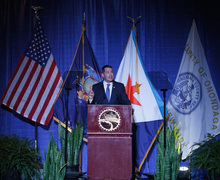President Donald Trump’s efforts to limit lobbying may not be enough, experts say
Moriah Ratner | Staff Photographer
President Donald Trump campaigned in Syracuse during primary season. He pushed ethics reform throughout his campaign.
Fulfilling a promise to “drain the swamp” during his first 100 days in office, United States President Donald Trump has signed an executive order limiting the ability of executive officials in his administration to lobby.
The order officially bans members of the executive branch from lobbying in all forms for five years and lobbying on behalf of foreign governments for the rest of their lives. This comes into effect after officials leave the administration, according to TIME. Incoming officials can lobby up until they take a post, and then must prove they are no longer a registered lobbyist, according to The Washington Post.
Experts and policy analysts have differing views on how powerful and executable the executive order, signed on Jan. 28, could be. Some lobbyists have also said that Trump’s transition and inauguration process cast doubts on how committed his administration is to combating the “swamp.” However, Trump has made other promises that could help close these gaps.
On the campaign trail, Trump made cleaning up corruption in Washington, D.C., one of his main talking points. In October 2016, he released a five-point plan on how he would reform ethics on Capitol Hill that echoes the features of the Jan. 28 executive order. It also included a call to Congress to institute its own five-year ban, a proposed law to ban foreign lobbyists from raising money for U.S. elections and the expansion of the definition of lobbying.
Trump also included ethics reform in a video in November that outlined his priorities for his first day in office, saying again that he was going to “drain the swamp” and “put America first.”
While these actions take a hard line against lobbying, the Trump administration’s actions prior to his executive order sent mixed signals to lobbyists. During the transition process, lobbyists were banned from contributing money to the inauguration and from going to transition headquarters, but reports from Politico show that they found ways around these obstacles.
Lobbyists were able to collect checks from others for the inauguration costs, despite being barred from contributing themselves, according to the Politico report.
They were also able to give direct input into the transition process even though they were not officially welcome to meet with officials at headquarters. Instead, they met at other locations in the capital, sent in resumes for key positions, gave written input on policies and were welcome at unpublicized “listening sessions.”
“I’ve known Donald Trump for 30 years. I think he’s serious for wanting to keep what he calls ‘special interests’ out of the process as much as possible,” Charlie Black, chairman of the lobbying firm Prime Policy Group, told Politico. “But that said, he kind of knows how these things work.”
While the executive order shows Trump taking a step toward fulfilling his promises, it falls far short of his proposed ethics plan, which received approval from good-government groups, according to The Atlantic.
Trump is not the first president to attempt to decrease corporate influence in D.C. When former President Barack Obama took office, he also mandated officials in his administration to limit their lobbying activities. Obama’s executive order blocked people who had lobbied in the previous two years from working in an agency they had lobbied, something Trump’s also includes.
Obama, however, only banned his officials from lobbying for two years after they left office. Even with that significantly shorter time span, Obama’s policy — as well as tighter lobbying restrictions enacted right before he entered office — had an effect on how lobbying evolved during his time in office.
Both the number of lobbyists and the amount of spending on lobbying decreased between 2008 and 2016. The number of registered lobbyists dropped from 13,740 in 2009 to 11,143 in 2016, according to the Center for Responsive Politics, which many experts attribute to decreasing registration but not decreasing influence.
This stems from the fact that the definition of lobbying in the Lobbying Disclosure Act is narrow. Currently, a lobbyist only has to register as such if they make more than $5,000 on lobbying per quarter, spend 20 percent or more of their time lobbying or contact more than one government official.
Many influencers in Washington narrowly avoid meeting these exact requirements and are then able to call themselves consultants or advisers, according to an article written by political scientists in The Washington Post.
By simply deregistering or not registering at all, these people are able to contribute to the corporate influence in Washington without having to follow all of the rules lobbyists do. This could be taken advantage of by Trump — and Obama — administration officials, according to experts in the Post article.
“Combined with a White House that may be deeply entangled with the president’s own business interests,” reads the Post article, “the increased likelihood that lobbyists may influence policy with little public scrutiny could be a recipe for corruption.”
Published on February 20, 2017 at 8:40 pm
Contact Delaney: dovanwey@syr.edu





